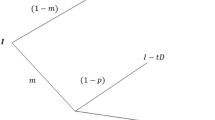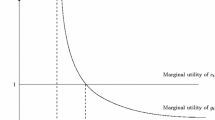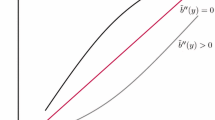Abstract
Different from traditional tax audit, supervision with self-audit is a combination of audit by the taxpayer himself and audit by the tax authority. This paper mainly studies a taxpayer’s optimal policy of tax evasion under supervision with self-audit and its related properties, in order to deduce some effective suggestions and theoretical bases to restrain tax evasion. Assuming that only a certain proportion of evaded tax can be discovered when the audit is executed, the authors first formulate a static model with self-audit. This model is divided into two stages. At the first stage, taxpayers declare their taxes, then the tax authority chooses audit objects, based on a known probability, and announces the result; if the taxpayer is chosen, he will enter the second stage, during which he has a chance to pay the evaded tax and the corresponding late fees and then is audited by the tax authority. The authors show the existence and uniqueness of the optimal amount of tax evasion at the first stage and the optimal proportion to self-expose at the second stage. The authors also discuss the related properties of the interior solution, and do elasticity analyses on some parameters. Besides, the authors extend the static model into the corresponding two-period model, and study the existence and uniqueness of the solution of the extended model. Finally, under the assumption that tax evasion can only be discovered with a certain probability when the audit is executed, the authors formulate another static model with self-audit and investigate its properties.
Similar content being viewed by others
References
H. R. Zhu, B. Z. Kang, Y. Q. Chen, and J. M. Zhang, Applied Tax System in China (in Chinese), China Financial and Economic Publishing House, Beijing, 1992, 1–21.
X. J. Yi and B. Y. Yang, Estimation on tax evasion in China and its economic effect (in Chinese), Finance and Taxation, 2004, 3: 67.
X. J. Yi, B. Y. Yang, and J. J. Yi, Estimation on scale of tax evasion in China and its economic effect (in Chinese), Journal of Finance and Economics, 30(1): 34.
M. G. Allingham and A. Sandmo, Income tax evasion: A theoretical analysis, Journal of Public Economics, 1972, 1(3): 323–338.
T. N. Srinivasan, Tax evasion: A model, Journal of Public Economics, 1973, 2(4): 339–346.
S. Yitzhaki, A note on income evasion: A theoretical analysis, Journal of Public Economics, 1974, 3(2): 201–202.
V. Christiansen, Two comments on tax evasion, Journal of Public Economics, 1980, 13(3): 389–393.
J. S. Feinstein, An econometric analysis of income tax evasion and its detection, Rand Journal of Economics, 1991, 22(1): 14–35.
A. S. Malik and R. M. Schwab, The economics of tax amnesties, Journal of Public Economics, 1991, 46(1): 29–49.
R. M. Cyert and M. H. DeGroot, Bayesian Analysis and Uncertainty in Economic Theory, Rowmanand Littlefield Press, Totowa, NJ, 1987.
P. Stella, An economic analysis of tax amnesties, Journal of Public Economics, 1991, 46(3): 383–400.
J. Andreoni, The desirability of a permanent tax amnesty, Journal of Public Economics, 1991, 45(2): 143–159.
K. Lee, Tax evasion and self-insurance, Journal of Public Economics, 2001, 81(1): 73–81.
A. Snow, S. Ronald, and J. Warren, Tax evasion under random audits with uncertain detection, Economics Letters, 2005, 88(1): 97–100.
K. Liu, J. J. Liu, and K. K. Lai, Audit of tax collection system, in Technical Report, Department of Management Science, City University of Hong Kong, 2005.
J. J. Liu and K. K. Lai, Tax office and corporation dynamic model based on the time value of tax payment (in Chinese), Systems Engineering in Theory and Practice, 2006, 26(10): 17–23.
J. J. Liu, A game model between tax authority and corporation–a strategy to avoid the cheating tax in export (in Chinese), Economic Mathematics, 1997, 14(2): 67–70.
J. J. Liu, A further discussion on the game model between tax authority and corporation (in Chinese), Mathematics in Practice and Theory, 1998, 28(4): 320–324.
H. Y. Chen and Z. L. Li, A game model between tax authority and corporation with cost factors (in Chinese), Operations Research and Management, 2001, 10(4): 55–58.
J. J. Liu, An analysis of non-zero-sum game between tax authority and corporation (in Chinese), Operations Research and Management, 2004, 13(5): 81–85.
T. T. Xiao, Classic model of tax evasion and its two-period expansion (in Chinese), in Proceedings of the 4th Annual Conference on Uncertainty, Hong Kong, London, Tokyo, 2006, 174–184.
M. L. Puterman, Markov Decision Processes, Wiley, New York, 1994.
A.A. Feinberg and A. Shwartz, Handbook of Markov Decisions Processes, Kluwer Academic Publishers, Boston, Dordrecht, London, 2002.
Author information
Authors and Affiliations
Corresponding author
Additional information
This research is partially supported by the National Natural Science Foundation of China under Grant Nos. 60674082, 70221001, and 70731003.
Rights and permissions
About this article
Cite this article
XIAO, T., LIU, K. & LAI, K.K. Tax Evasion: Models with Self-Audit. J Syst Sci Complex 21, 487–518 (2008). https://doi.org/10.1007/s11424-008-9131-9
Received:
Published:
Issue Date:
DOI: https://doi.org/10.1007/s11424-008-9131-9




